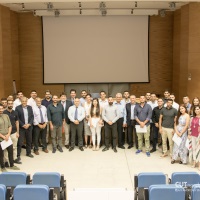
The international Cyprus Poster Triennial (CPT) is a nonprofit institution that aims to promote and disseminate knowledge and creativity in the field of graphic design by focusing on the poster as a major medium of visual communication. From the early printing of broadsides in the beginning of the 19th century to the present digital era, posters have been influential not only as vehicles that provide information but also as tools responsible for social change, developing awareness on crucial issues, dissemination of revolutionary or political ideas and propaganda.
The aspiration of the CPT is to establish a graphic design event in the Mediterranean at a place that, on the one hand, can function as a bridge between East and West, and on the other, can bring together designers from all over the world with a variety of perspectives to meet and celebrate the wondrous power of the graphic poster. We welcomed poster submissions from any part of the world, as long as they did not include offensive material against any ethnicity, nationality, gender, religion or physical condition. Participation in the Triennial was open to all talent, emerging or established, and did not require any submission fees, as the entire venture depended exclusively on voluntary work and sponsorship.
Under this scope of thinking, the international Cyprus Poster Triennial (CPT) provided six thematic areas to accommodate different design proposals as follows:
A. BORDERS (CRACKS OF VANITY AND CRACKS OF UNITY): Borders are agreed limitations between two or more parties, as exemplified in the geographical borders drawn as administrative boundaries between nation states. Borders can also be social and cultural, visible or invisible, real or imagined, tangible or virtual, natural or man-made. They are double faced, looking both in and out, separating and uniting as they can function both as a dividing line and as a meeting point, as an end and a beginning. We mostly structure our self-identity through borders that operate as contours of our individual/ private sphere and as interfaces with the collective/ public sphere. Borders can be respected or violated, maintained or transgressed, evolving in the constant flow of natural events and human relations. Under this category we welcome posters negotiating the aforementioned thoughts.
B. MULTILINGUAL POSTERS: Multilingual Posters develop typographic communication systems so as to accommodate text in more than one language. Such a challenging task needs not only to satisfy aesthetic and hierarchical criteria of Typography, but also to balance the information throughout the design space. Under this category, we welcome Posters that make use of more than one alphabetic system, but using at least one language from among the six official Languages of the United Nations (UN) or one of the three procedural Languages of the European Union (EU).
C. VISUALISING THE NATION AND PLACE-BRANDING POSTERS: Nations and places are often treated as brand products and have been central to many theoretical and practical visual communication studies. Aiming to boost the national economy, nation or destination branding posters intensify the image of the nation and target domestic or international audiences. Nation/place branding posters reflect the self-perception of a culture as it conveys what features it deems appealing to others within current global and local contexts, and are valuable artefacts of communication design content. This category welcomes posters that have nations and places central to their promotional messages.
D. POSTERS NEGOTIATING THE ART OF THE SPECTACLE: For the purpose of this thematic we understand Spectacle as an Act. A theatric, musical, artistic or any other performance is seen as a culturally driven act. In Guy Debord’s The Society of the Spectacle, “The Spectacle is not a collection of images, but a social relation among people, mediated by images”. Under this category we welcome posters negotiating cultural action or activities as spectacle.
E. THE NON-TYPE POSTER: Visualising language is for graphic designers a serious task. Anyone who deals with Writing will quickly ascertain that the need to show is equally essential with the need to tell. Designers often “tell” stories that leave viewers with very little to think about. On the other hand, messages open to interpretation are for poster designers a fascinating and provocative endeavour. Under this category, we welcome Posters that explore the communication of messages without the typographic use of a spoken language.
F. THE CYPRIOT DIALECTS: Linguistic varieties that may differ in terms of grammar, vocabulary and phonology, are distinct entities delineated by geographical and social borders, thus defined or implied by the autonomy or heteronomy of different dialects. When dialects are being graphematically represented, with or without coded standard forms, visual graphetics promote exploration, inspiration, innovation and originality for the recognition of distinct features, character shapes and composition. Under this category, we welcome Posters that explore Cypriot dialects in terms of design and visual rendering.
The international Cyprus Poster Triennial (CPT) is an initiative by Evripides Zantides, Omiros Panayides, and Savvas Xinaris, professors and practitioners of graphic and visual communication. The exhibition will take place from the 1st until the 31st of July 2019 at the NeMe Arts Centre in Limassol. The event is organised by the Semiotic and Visual Communication Research Lab of the Department of Multimedia and Graphic Arts at the Cyprus University of Technology. The Cyprus Poster Triennial 2019 open call has received 2410 posters from 53 countries. After a double, blind reviewed selection process, only 134 posters were accepted for participation. The opening of the exhibition will take place on Friday, 28 June 2019 at 20:30. Further details can be found on www.cpt.com.cy. The Cyprus Poster Triennial is supported by the Cyprus Association of Graphic Designers and Illustrators (CAGDI), Frederick University, Laser printers, NeΜe Art Center and +design magazine.
Times Higher Education: To Τεχνολογικό Πανεπιστήμιο Κύπρου 63ο καλύτερο νεαρό πανεπιστήμιο διεθνώς, και το πρώτο σε Κύπρο και Ελλάδα

The international Cyprus Poster Triennial (CPT) is a nonprofit institution that aims to promote and disseminate knowledge and creativity in the field of graphic design by focusing on the poster as a major medium of visual communication. From the early printing of broadsides in the beginning of the 19th century to the present digital era, posters have been influential not only as vehicles that provide information but also as tools responsible for social change, developing awareness on crucial issues, dissemination of revolutionary or political ideas and propaganda.
The aspiration of the CPT is to establish a graphic design event in the Mediterranean at a place that, on the one hand, can function as a bridge between East and West, and on the other, can bring together designers from all over the world with a variety of perspectives to meet and celebrate the wondrous power of the graphic poster. We welcomed poster submissions from any part of the world, as long as they did not include offensive material against any ethnicity, nationality, gender, religion or physical condition. Participation in the Triennial was open to all talent, emerging or established, and did not require any submission fees, as the entire venture depended exclusively on voluntary work and sponsorship.
Under this scope of thinking, the international Cyprus Poster Triennial (CPT) provided six thematic areas to accommodate different design proposals as follows:
A. BORDERS (CRACKS OF VANITY AND CRACKS OF UNITY): Borders are agreed limitations between two or more parties, as exemplified in the geographical borders drawn as administrative boundaries between nation states. Borders can also be social and cultural, visible or invisible, real or imagined, tangible or virtual, natural or man-made. They are double faced, looking both in and out, separating and uniting as they can function both as a dividing line and as a meeting point, as an end and a beginning. We mostly structure our self-identity through borders that operate as contours of our individual/ private sphere and as interfaces with the collective/ public sphere. Borders can be respected or violated, maintained or transgressed, evolving in the constant flow of natural events and human relations. Under this category we welcome posters negotiating the aforementioned thoughts.
B. MULTILINGUAL POSTERS: Multilingual Posters develop typographic communication systems so as to accommodate text in more than one language. Such a challenging task needs not only to satisfy aesthetic and hierarchical criteria of Typography, but also to balance the information throughout the design space. Under this category, we welcome Posters that make use of more than one alphabetic system, but using at least one language from among the six official Languages of the United Nations (UN) or one of the three procedural Languages of the European Union (EU).
C. VISUALISING THE NATION AND PLACE-BRANDING POSTERS: Nations and places are often treated as brand products and have been central to many theoretical and practical visual communication studies. Aiming to boost the national economy, nation or destination branding posters intensify the image of the nation and target domestic or international audiences. Nation/place branding posters reflect the self-perception of a culture as it conveys what features it deems appealing to others within current global and local contexts, and are valuable artefacts of communication design content. This category welcomes posters that have nations and places central to their promotional messages.
D. POSTERS NEGOTIATING THE ART OF THE SPECTACLE: For the purpose of this thematic we understand Spectacle as an Act. A theatric, musical, artistic or any other performance is seen as a culturally driven act. In Guy Debord’s The Society of the Spectacle, “The Spectacle is not a collection of images, but a social relation among people, mediated by images”. Under this category we welcome posters negotiating cultural action or activities as spectacle.
E. THE NON-TYPE POSTER: Visualising language is for graphic designers a serious task. Anyone who deals with Writing will quickly ascertain that the need to show is equally essential with the need to tell. Designers often “tell” stories that leave viewers with very little to think about. On the other hand, messages open to interpretation are for poster designers a fascinating and provocative endeavour. Under this category, we welcome Posters that explore the communication of messages without the typographic use of a spoken language.
F. THE CYPRIOT DIALECTS: Linguistic varieties that may differ in terms of grammar, vocabulary and phonology, are distinct entities delineated by geographical and social borders, thus defined or implied by the autonomy or heteronomy of different dialects. When dialects are being graphematically represented, with or without coded standard forms, visual graphetics promote exploration, inspiration, innovation and originality for the recognition of distinct features, character shapes and composition. Under this category, we welcome Posters that explore Cypriot dialects in terms of design and visual rendering.
The international Cyprus Poster Triennial (CPT) is an initiative by Evripides Zantides, Omiros Panayides, and Savvas Xinaris, professors and practitioners of graphic and visual communication. The exhibition will take place from the 1st until the 31st of July 2019 at the NeMe Arts Centre in Limassol. The event is organised by the Semiotic and Visual Communication Research Lab of the Department of Multimedia and Graphic Arts at the Cyprus University of Technology. The Cyprus Poster Triennial 2019 open call has received 2410 posters from 53 countries. After a double, blind reviewed selection process, only 134 posters were accepted for participation. The opening of the exhibition will take place on Friday, 28 June 2019 at 20:30. Further details can be found on www.cpt.com.cy. The Cyprus Poster Triennial is supported by the Cyprus Association of Graphic Designers and Illustrators (CAGDI), Frederick University, Laser printers, NeΜe Art Center and +design magazine.




